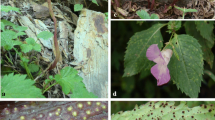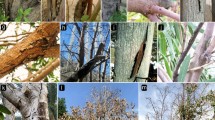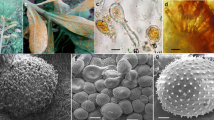Abstract
A rust fungus collected from common ragweed (Ambrosia artemisiifolia) in Texas, USA, was identified as belonging to the Puccinia xanthii morphospecies based on its nrDNA ITS sequence. Pathogenicity studies carried out with this rust accession under quarantine conditions in the UK showed that the fungus was highly virulent on A. artemisiifolia plants from Australia. Recently, P. xanthii has been proposed as a potential classical biological control agent (CBCA) for common ragweed in its invasive range, focusing on Europe, despite previous doubts about its biocontrol potential. The results of the pathogenicity tests reported here support the suitability of this pathogen as a CBCA for common ragweed.

Similar content being viewed by others
References
Alaei, H., De Backer, M., Nuytinck, J., Maes, M., Höfte, M., & Heungens, K. (2009). Phylogenetic relationships of puccinia horiana and other rust pathogens of chrysanthemum × morifolium based on rDNA ITS sequence analysis. Mycological Research, 113, 668–683.
Alcorn, J. L. (1976). Host range of puccinia xanthii. Transactions of the British Mycological Society, 66, 365–367.
Batra, S. W. T. (1981). Puccinia xanthii forma specialis ambrosia-trifidae. Mycopathologia, 73, 61–64.
Chauvel, B., Dessaint, F., Cardinal-Legrand, C., & Bretagnolle, F. (2006). The historical spread of Ambrosia artemisiifolia L. in France from herbarium records. Journal of Biogeography, 33, 665–673.
Corpet, F. (1988). Multiple sequence alignment with hierarchical clustering. Nucleic Acids Research, 16, 10881–10890.
Evans, H. C. (1997). Parthenium hysterophorus: a review of its weed status and the possibilities for biological control. Biocontrol News and Information, 18, 89–98.
Evans, H. C. (1998). Major Indian weeds of Neotropical origin and the possibilities for collaborative biocontrol projects. In: P. Ferrar, R. Muniappan, K. P. Jayanth (Eds.), Proceedings of the Fourth International Workshop on Biological Control and Management of Chromolaena odorata (pp. 55–62). Mangilao, Guam: Publication No. 216, Agricultural Experiment Station, University of Guam.
Evans, H. C. (2013). Biological control of weeds with fungi. In F. Kempken (Ed.), The mycota XI. Agricultural applications (pp. 145–172). Berlin-Heidelberg: Springer.
Evans, H. C., & Ellison, C. A. (1990). Classical biological control of weeds with micro-organisms: past, present, prospects. Aspects of Applied Biology, 24, 39–49.
Farr, D. F., & Rossman, A. Y. (2015). Fungal databases, systematic mycology and microbiology laboratory. USDA: ARS Retrieved May 2, 2015, from http://nt.ars-grin.gov/fungaldatabases/.
Feau, N., Vialle, A., Allaire, M., Maier, W., & Hamelin, R. C. (2011). DNA barcoding in the rust genus chrysomyxa and its implications for the phylogeny of the genus. Mycologia, 103, 1250–1266.
Filatov, D. A. (2002). ProSeq: a software for preparation and evolutionary analysis of DNA sequence data sets. Molecular Ecology Notes, 2, 621–624.
Gaudeul, M., Giraud, T., Kiss, L., Shykoff, J. A. (2011). Nuclear and chloroplast microsatellites show multiple introductions in the worldwide invasion history of common ragweed, Ambrosia artemisiifolia (Asteraceae). PLOS ONE, 6:(3), e17658. doi:10.1371/journal.pone.0017658.
Gerber, E., Schaffner, U., Gassmann, A., Hinz, H. L., Seier, M., & Mueller-Schaerer, H. (2011). Prospects for biological control of Ambrosia artemisiifolia in Europe: learning from the past. Weed Research, 51, 559–573.
Ginns, J. H. (1986). Compendium of plant disease and decay fungi in Canada 1960-1980. Research branch, publication 1813. Ottawa: Agriculture Canada.
Gladieux, P., Giraud, T., Kiss, L., Genton, B. J., Jonot, O., & Shykoff, J. A. (2011). Distinct invasion sources of common ragweed (Ambrosia artemisiifolia) in eastern and western Europe. Biological Invasions, 13, 933–944.
Kiss, L. (2007a). Why is biocontrol of common ragweed (Ambrosia artemisiifolia), the most allergenic weed in eastern Europe, still only a hope? In C. Vincent, M. Goettel, & G. Lazarovits (Eds.), Biological control - a global perspective (pp. 80–91). Wallingford, UK: CABI Publishing International.
Kiss, L. (2007b). Is puccinia xanthii a suitable biological control agent of Ambrosia artemisiifolia? Biocontrol Science and Technology, 17, 535–539.
Kovács, G. M., Balázs, T., & Pénzes, Z. (2007). Molecular study of arbuscular mycorrhizal fungi colonizing the sporophyte of the eusporangiate rattlesnake fern (botrychium virginianum, ophioglossaceae). Mycorrhiza, 17, 597–605.
Lu, G.-Z., Yang, H., Sun, X.-D., Yang, R.-X., & Zhao, Z.-H. (2004). Puccinia xanthii f. sp. ambrosiae-trifidae, a newly recorded rust taxon on ambrosia in China. Mycosystema, 23, 310–311.
Morin, L., Auld, B. A., & Brown, J. F. (1993). Host range of puccinia xanthii and postpenetration development on xanthium occidentale. Canadian Journal of Botany, 71, 959–965.
Morin, L., van der Merwe, M., Hartley, D., & Muller, P. (2009). Putative natural hybrid between puccinia lagenophorae and an unknown rust fungus on senecio madagascariensis in KwaZulu-Natal, South Africa. Mycological Research, 113, 725–736.
Parmelee, J. A. (1977). Puccinia xanthii. Fungi canadenses no. 99. National mycological herbarium, biosystematics research institute. Ottawa: Agriculture Canada.
Pfunder, M., Schürch, S., & Roy, B. A. (2001). Sequence variation and geographic distribution of pseudoflower-forming rust fungi (uromyces pisi s. lat.) on euphorbia cyparissias. Mycological Research, 105, 57–66.
Seier, M. K. (2005). Exotic beneficials in classical biological control of invasive alien weeds: friends or foes? In D. V. Alford & G. F. Backhaus (Eds.) BCPC Symposium Proceedings No. 81; Plant Protection and Plant Health in Europe: Introduction and Spread of Invasive Species (pp. 191–196). Hampshire, UK: The British Crop Protection Council.
Seier, M. K., Harvey, J. L., Romero, A., & Kinnersley, R. P. (1997). Safety testing of the rust puccinia melampodii as a potential biocontrol agent of Parthenium hysterophorus L. In M. Mahadevappa, & V. C. Patil (Eds.), Proceedings of the first international conference on parthenium management (pp. 63–69). Dharwad, Karnataka, India: University of Agricultural Sciences.
Seier, M. K., Morin, L., Van der Merwe, M., Evans, H. C., & Romero, A. (2009). Are the microcyclic rust species puccinia melampodii and puccinia xanthii conspecific? Mycological Research, 113, 1271–1282.
Staden, R., Beal, K. F., & Bonfield, J. K. (2000). The staden package, 1998. Methods in Molecular Biology, 132, 115–130.
Tanner, R. A., Ellison, C. A., Seier, M. K., Kovács, G. M., Kassai-Jáger, E., Berecky, Z., Varia, S., Djeddour, D., Chand Singh, M., Csiszár, A., Csontos, P., Kiss, L., & Evans, H. C. (2015). Puccinia komarovii var. glanduliferae var. nov.: a fungal agent for the biological control of Himalayan balsam (impatiens glandulifera). European Journal of Plant Pathology, 141, 247–266.
Tomley, A., Evans, H., Ellison, C., Seier, M., Thomas, S., & Djeddour, D. (2004). Release strategies and associated factors affecting the establishment of four rust fungi introduced into Australia between 1991 and 2001 for the biocontrol of Parthenium hysterophorus, cryptostegia grandiflora and lantana camara. In J. M. Cullen, D. T. Briese, D. J. Kriticos, W. M. Lonsdale, L. Morin, & J. K. Scott (Eds.), Proceedings of the XI international symposium on biological control of weeds (p. 612). Canberra, Australia: CSIRO.
Zhang, P., Lu, G. Z., Sun, X. D., Zhang, W., Qu, B., & Tian, X. L. (2011). The infection process of puccinia xanthii f. sp. ambrosiae-trifidae on ambrosia trifida. Botany, 89, 771–777.
Acknowledgments
We thank W. A. (Bill) Palmer (Queensland Department of Lands) for sending herbarium material of the North American rust. We acknowledge the support of the EU COST Action FA1203 ‘Sustainable management of Ambrosia artemisiifolia in Europe (SMARTER)’.
Author information
Authors and Affiliations
Corresponding author
Rights and permissions
About this article
Cite this article
Kassai-Jáger, E., Seier, M.K., Evans, H.C. et al. Molecular identification and pathogenicity assessment of a rust fungus infecting common ragweed (Ambrosia artemisiifolia) in its native North American range. Eur J Plant Pathol 145, 81–87 (2016). https://doi.org/10.1007/s10658-015-0815-4
Accepted:
Published:
Issue Date:
DOI: https://doi.org/10.1007/s10658-015-0815-4




